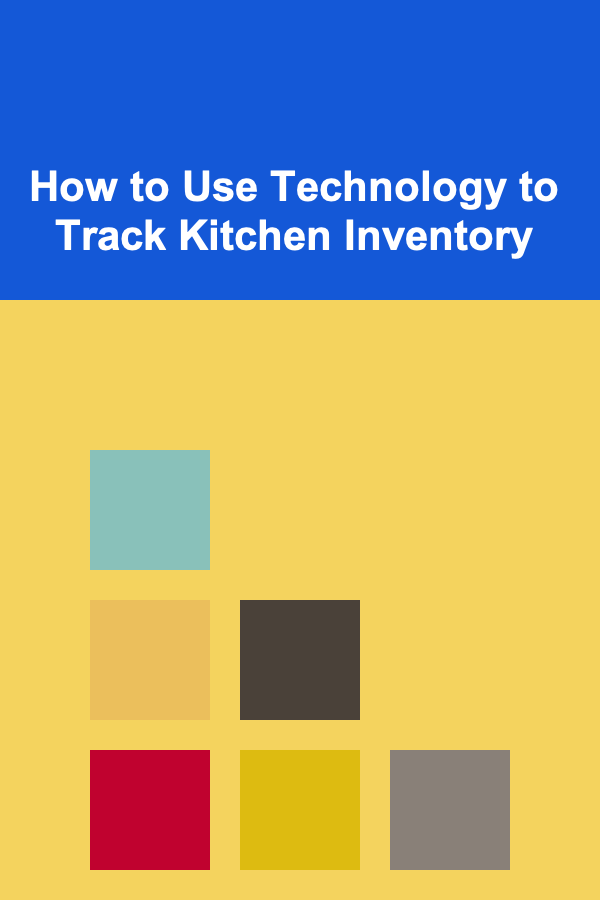
How to Use Technology to Track Kitchen Inventory
ebook include PDF & Audio bundle (Micro Guide)
$12.99$5.99
Limited Time Offer! Order within the next:

In the modern culinary world, effective kitchen inventory management is paramount for both professional chefs and home cooks. The integration of technology has transformed traditional methods of tracking ingredients, enabling efficiency, reducing waste, and optimizing meal preparation. This comprehensive guide will explore various technological solutions and strategies to help you track your kitchen inventory effectively.
The Importance of Kitchen Inventory Management
Effective inventory management is a critical component of running any kitchen, whether in a restaurant or at home. Here's why it matters:
1. Reducing Waste
By keeping track of your ingredients, you can minimize spoilage and waste. Understanding what you have on hand enables better meal planning and reduces unnecessary purchases.
2. Cost Control
A well-managed inventory helps control costs by preventing overbuying, allowing you to use your budget more efficiently.
3. Time Efficiency
When you know exactly what you have in stock, you can streamline meal prep processes, saving time and effort during busy cooking sessions.
4. Enhanced Meal Planning
Tracking inventory aids in planning meals based on available ingredients, making it easier to create shopping lists and manage weekly menus.
5. Improved Food Safety
Proper inventory management ensures that perishable items are used before they expire, contributing to overall food safety and quality.
Traditional Inventory Tracking Methods
Before diving into technology, let's briefly review traditional methods of inventory management.
1. Manual Logs
Many kitchens still rely on handwritten logs to track inventory. While simple, this method can be prone to human error and may not provide real-time data.
2. Spreadsheets
Using spreadsheet software like Microsoft Excel or Google Sheets allows for better organization but requires manual updates and constant vigilance to ensure accuracy.
3. Physical Counts
Regularly taking physical counts of inventory is essential, but it can be labor-intensive and time-consuming, especially in larger kitchens.
Benefits of Using Technology in Inventory Management
Technology offers numerous advantages over traditional inventory methods:
1. Real-Time Tracking
Modern inventory systems provide real-time data on ingredient availability, allowing for quick decision-making.
2. Automation
Automated systems reduce the need for manual entry, minimizing human errors and saving time.
3. Data Analysis
With technology, you can analyze trends over time, such as usage patterns and seasonal demand, leading to more informed purchasing decisions.
4. Accessibility
Cloud-based systems allow users to access inventory data from multiple devices, facilitating collaboration among kitchen staff and management.
5. Notifications and Alerts
Many technology solutions can send alerts when stock levels fall below a certain threshold, helping to prevent shortages.
Choosing the Right Inventory Management System
Selecting an appropriate inventory management system is crucial for success. Consider the following factors:
1. Size of Your Kitchen
Different systems cater to various kitchen sizes. Small home kitchens may require simpler apps, while restaurants might need comprehensive solutions.
2. Types of Ingredients
Take into account whether you deal primarily with dry goods, perishables, or specialty items, as this may influence your choice of software.
3. User-Friendliness
Choose a system that is intuitive and easy to navigate so that all kitchen staff can use it comfortably.
4. Budget
Evaluate your budget constraints. Some systems offer free versions with limited features, while others require subscriptions or one-time payments.
5. Integration Capabilities
If you're using other technology solutions, consider how well new inventory software integrates with those systems for seamless operations.
Apps and Software Solutions
Here are some popular apps and software solutions designed for kitchen inventory management:
1. BlueCart
BlueCart is an online ordering platform that provides inventory management solutions specifically for restaurants. It features tracking, ordering, and invoicing functionalities.
2. Pantry Check
This mobile app allows users to manage their pantry inventory by simply scanning barcodes. It tracks expiration dates and sends alerts when items are low.
3. Cooks Illustrated Cookbook App
This app includes recipe management along with an inventory tracking feature, allowing users to see what's on hand while planning meals.
4. FreshCheq
FreshCheq is designed for restaurants, providing tools for tracking inventory, temperature logs, and food safety compliance.
5. SimpleThermo
Aimed at food businesses, SimpleThermo offers an easy-to-use platform for managing inventory alongside temperature monitoring to maintain food safety.
Barcode Scanning Technology
Barcode scanning technology can significantly streamline inventory management.
1. How It Works
Barcodes are unique identifiers assigned to products. By scanning these codes with a smartphone or scanner, users can quickly update inventory records without manual entry.
2. Advantages of Barcode Scanning
- Speed: Scanning is faster than manual entry.
- Accuracy: Reduces human error in data entry.
- Efficiency: Simplifies the process of adding new items or removing expired ones.
3. Implementation
To implement barcode scanning:
- Obtain a Barcode Scanner: Many smartphones can act as scanners with the right app.
- Create Barcodes for Your Inventory: Assign barcodes to each item in your kitchen.
- Integrate with Your Inventory System: Ensure that your inventory software supports barcode integration.
Implementing Smart Kitchens
Smart kitchen technology takes inventory management to another level. Here are some ways to incorporate smart technology:
1. Smart Fridges
These appliances can monitor contents and send notifications about expiration dates or low stock levels. Many models even allow for direct reordering through compatible apps.
2. IoT Devices
Internet of Things (IoT) devices can track inventory levels in real-time and sync data across multiple platforms, creating an interconnected kitchen ecosystem.
3. Smart Labels
Use NFC-enabled labels that can provide product information and current status when scanned with a smartphone. These can include usage suggestions or recipes based on what's in stock.
Best Practices for Tracking Kitchen Inventory
To maximize the effectiveness of your technology-driven inventory system, follow these best practices:
1. Consistent Updates
Ensure that inventory data is updated consistently to reflect accurate stock levels. Regular checks and audits can help maintain this.
2. Categorization
Organize inventory into logical categories, making it easy to locate items quickly. Common categories include spices, grains, meats, and vegetables.
3. User Training
Train kitchen staff on how to use technology effectively. Familiarity with the system encourages consistent and accurate usage.
4. Regular Audits
Conduct periodic inventory audits to verify that digital records match physical stock. This practice helps identify discrepancies early.
5. Feedback Loop
Create a feedback loop where kitchen staff can report issues with inventory management. This input can provide insights into improving the system.
Maintaining Your Inventory System
Once you've established a technology-driven inventory system, maintaining it is crucial for long-term success.
1. Engagement
Encourage staff engagement with the inventory system. Recognize and reward diligent tracking efforts to foster greater accountability.
2. Software Updates
Keep your inventory management software up to date to benefit from security patches, new features, and improved functionality.
3. Adaptability
Be open to adapting your inventory management strategies as your kitchen evolves. This flexibility ensures continued relevance and effectiveness.
4. Data Backup
Regularly back up your inventory data to prevent loss due to technical failures. Cloud storage or external hard drives can serve this purpose.
Conclusion
Utilizing technology to track kitchen inventory is a game-changer for both home cooks and professional chefs. With the right tools and strategies, you can enhance efficiency, reduce waste, and optimize your culinary experience. By understanding the importance of proper inventory management, evaluating your needs, and selecting suitable technology solutions, you can transform your kitchen into an organized and efficient workspace.
Regular maintenance and ongoing training for staff further ensure the longevity and effectiveness of your inventory system. Start today by implementing these strategies, and enjoy the benefits of a well-managed kitchen that's ready to inspire culinary creativity!
Reading More From Our Other Websites
- [Home Family Activity 101] How to Throw a Theme-Night Family Dance Party for Maximum Fun
- [Organization Tip 101] How to Make Use of Cork Boards for Important Reminders
- [Home Security 101] How to Integrate Home Security with Other Smart Home Devices
- [Organization Tip 101] How to Use Travel Cases for Safe Jewelry Storage on the Go
- [Personal Care Tips 101] How to Choose Sustainable and Eco-Friendly Personal Care Products
- [Home Storage Solution 101] How to Use Multi-Functional Furniture for Extra Home Storage
- [Personal Care Tips 101] How to Select Toothpaste for Children
- [Home Renovating 101] How to Declutter and Organize Before Renovating Your Home
- [Sewing Tip 101] Beginner‑Friendly Wardrobe Essentials: Simple Sewing Patterns for New Sewists
- [Home Rental Property 101] How to Rent Homes with a Gas Range for Cooking Enthusiasts

10 Creative and Affordable Gift Ideas for Any Occasion
Read More
How to Keep Your Budget Flexible and Adaptable
Read More
How to Transform Your Space with Thrift Store Finds
Read More
The Mobile Developer's Guide: Mastering App Development for iOS and Android
Read More
How To Explore Quantum Computing for Personalized Medicine
Read More
How to Protect Your Credit Card from Data Breaches
Read MoreOther Products

10 Creative and Affordable Gift Ideas for Any Occasion
Read More
How to Keep Your Budget Flexible and Adaptable
Read More
How to Transform Your Space with Thrift Store Finds
Read More
The Mobile Developer's Guide: Mastering App Development for iOS and Android
Read More
How To Explore Quantum Computing for Personalized Medicine
Read More